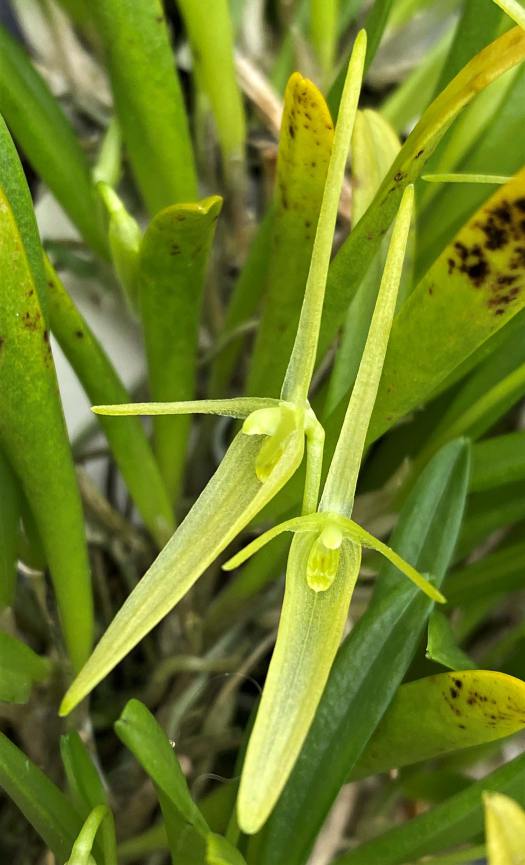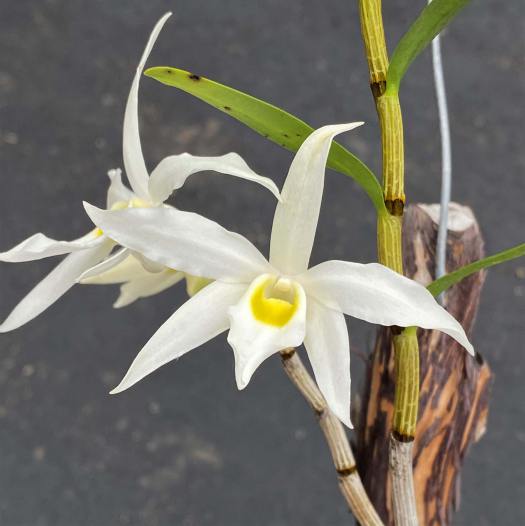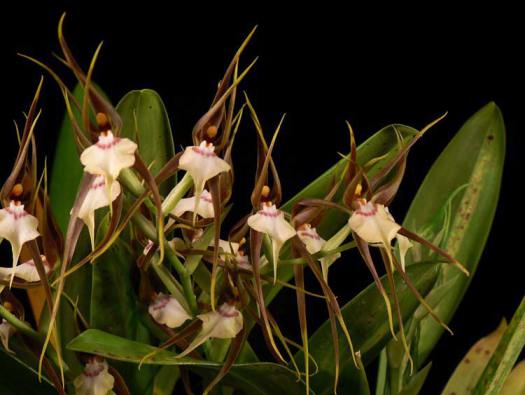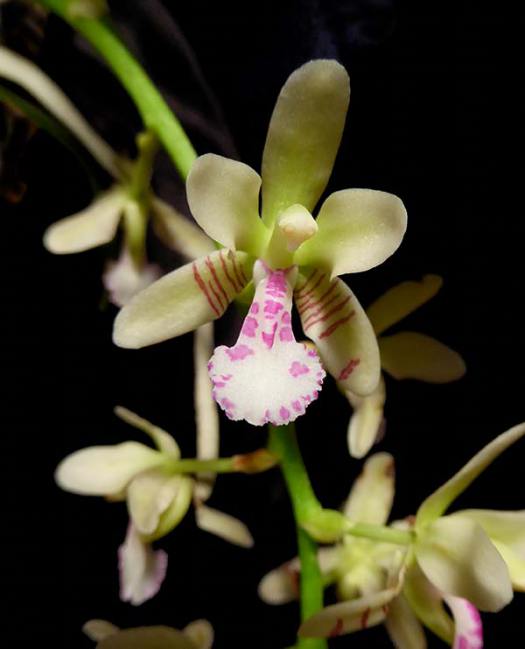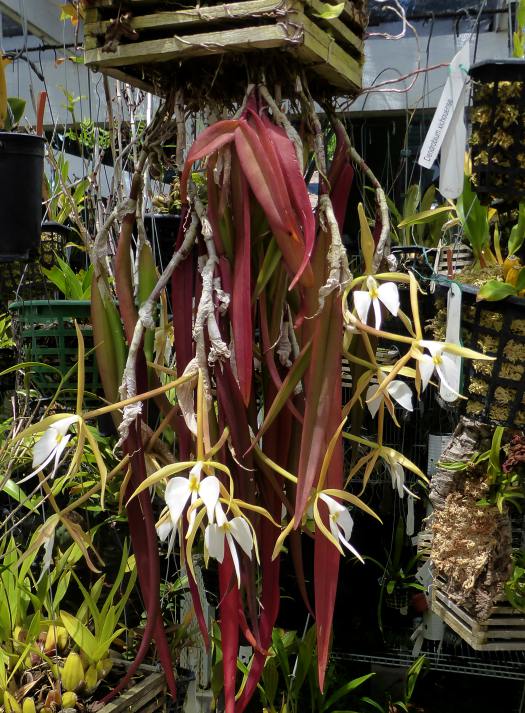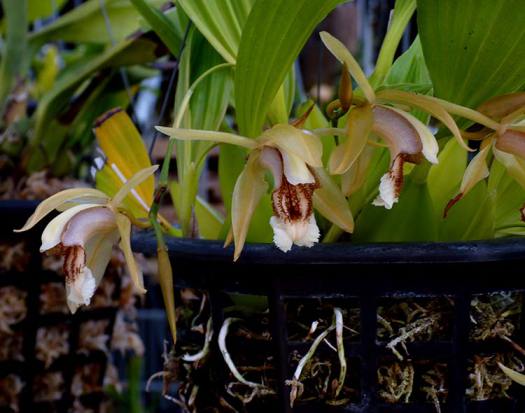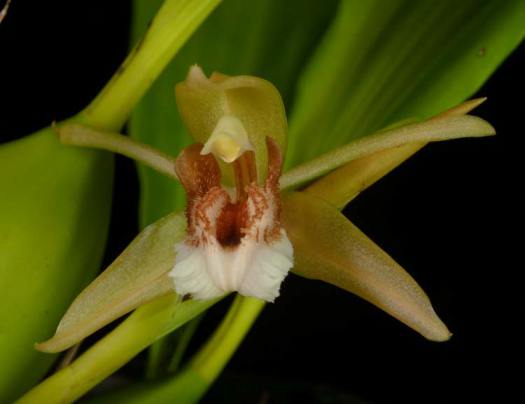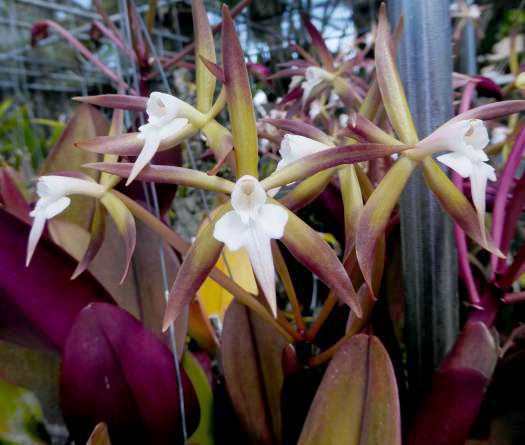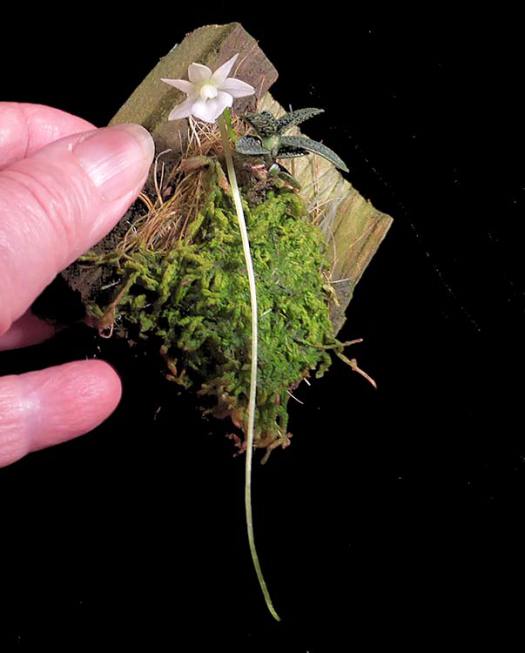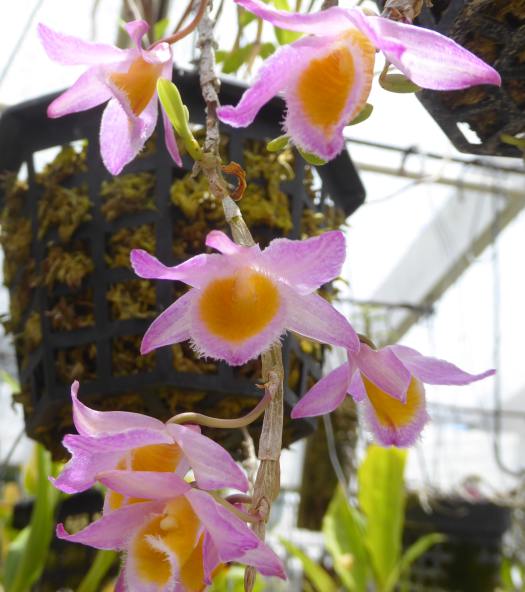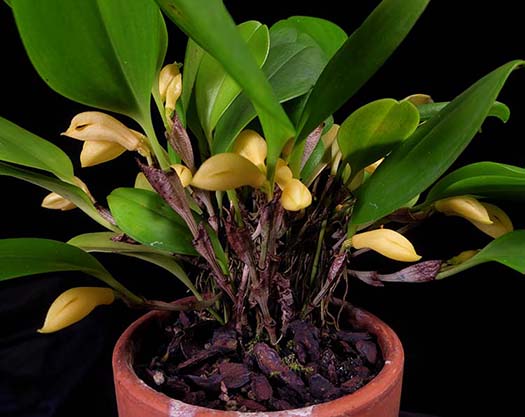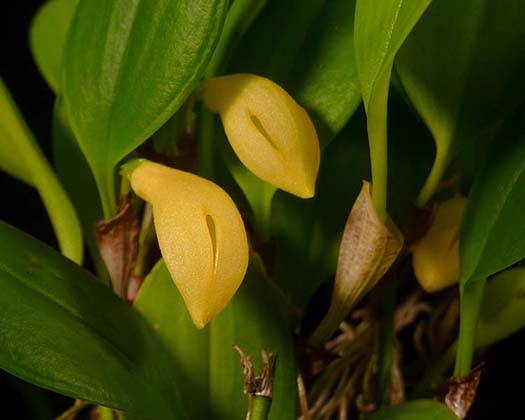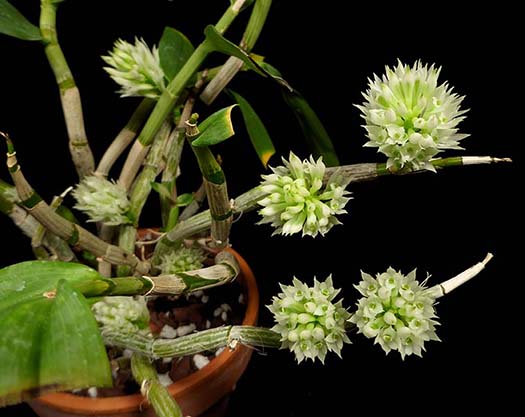June 2020
From Glenda Urmacher:
|
|
Epidendrum parkinsonianaumHave had this for 7 years and this is the first blooms. Grown outside under grape arbor. Killed 3 others before this one. |
|
From Scott McGregor:
|
|
Angraecum teretifoliumGreat flower to plant ratio on this Angraecum! |
|
Ansellia africana 'Kenya Dark'This one gets big (mine is still small at 42” tall), but has big sprays from the top and sides of the maturing pseudobulbs, with long-lasting flowers. It prefers very bright light and can handle some hours of full sun. Stiff roots grow upward from the base, forming a basket that catches leaves and other nutritious debris. |
|
 Barbosella cucullataLots of vertical green 1.5” flowers! |
|
Bulbophyllum wendlandianumA relatively easy outdoor-growing Bulbophyllum that has an attractive compact growth habit. The preposterous 4” red and yellow flowers are festooned with odd ornamentations. |
|
Bulbophyllum yasnae (thaiorum, papillos yellow form)Nice saturated colors on this easy-to-grow Bulbophyllum, and mercifully scent-less too! |
Cattleya (Laelia) harpophyllaThis is a great species with cheerful, fully saturated, long-lasting, bright orange flowers. |
Capanemia uliginosa (superflua)I find this micro-mini twig epiphyte to be challenging—it needs to be mounted, grown bright and with frequent watering. An entire flower spike is about an inch with quarter-inch flowers, and if you can get close enough, fragrant as well. |
|
Cynorkis uncinataPretty 1.5-2” flowers adorn this deciduous terrestrial from Africa. I find it to be the easiest and most reliable Cynorkis—I leave it outside on the patio all year in a 10” pot, water/fertilize and give it some sun when growing, stop watering when the leaves die back after flowering and that’s about it. |
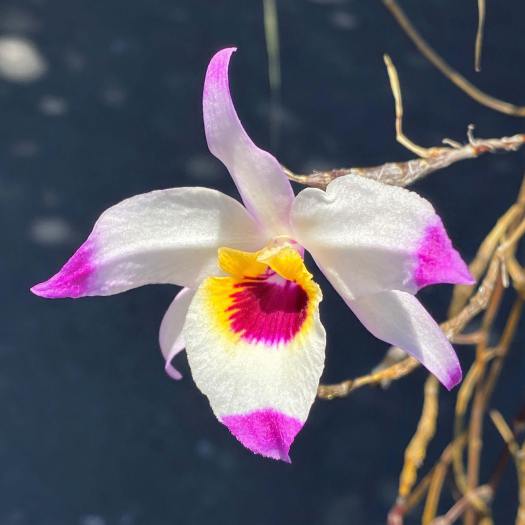 |
Dendrobium falconeriA very pretty Himalayan species with red, yellow, white and magenta flowers. |
|
Dendrobium hancockiiLots of small but pretty yellow flowers… |
|
Diplocaulobium arachnoideumCompare with D. aratiferum, which booms around the same time. I suspect these are either the same or related species. |
|
Diuris drummondiiThe last of my Australian “donkey orchids” to open. |
Domingoa (Nageliella) angustifoliaA long-blooming mini that re-blooms off dry and seemingly dead spikes from prior years—don’t cut them off until you’re sure! |
Dracula simiaA fun one—monkey face flowers! |
|
 |
|
Encyclia (Cattleya) citrinaThis is an odd plant that grows completely downward—new growths, and one large, heavy, waxy flower on a floppy stem that points straight down. It must be grown mounted, and prefers bright light, good water and cool conditions. The flower smells strongly of lemons. |
Sarcochilus falcatus ('select' x 'SanBar Marvel')For some reason I have trouble with Sarcochilus. I originally got some species that came virused and had to be destroyed. The new ones seem to grow well enough but just don’t flower much for me growing outside. Cultural advice welcome! Here’s my line bred species S. falcatus, with one fragrant flower. |
Maxillaria minutaAn aptly named mini-Maxi. The dark red flowers are nestled into the leaves, and strongly fragrant of cinnamon. |
Maxillaria (Christensonella) vittelinifloraA very tiny Maxillaria—cute plant. |
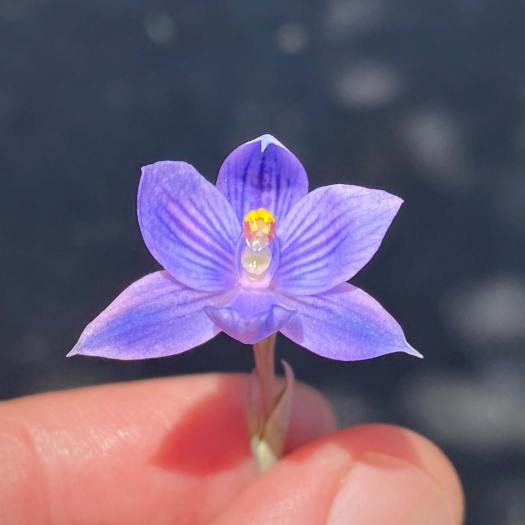 |
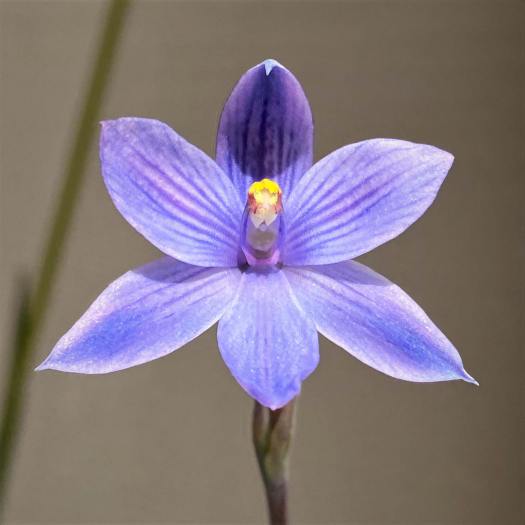 |
Thelymitra cyaneaMy last Thelymitra to bloom—the “swamp sun orchid” has pretty blue and violet veining. This one is only briefly deciduous in the summer. It wants to be blue, but ends up a mix of blue, purple and rose. |
|
Sobralia xantholeucaMy first Sobralia of the season! I love Sobralias and have over a dozen species and a handful of hybrids. They range in height from 1’ to 10’ and while their individual flowers may only last a day or two, they rebloom repeatedly on each cane such that they put on a show from May until October each year. S. xantholeuca is a variable species, sometimes with fringe like this one, flowers about 4” across, somewhat fragrant, and a reliable all-summer bloomer. They are easy outdoor growers, and like about the same conditions as cymbidiums (but are much prettier, both in-bloom and out). |

Two species!Our native Pseudacris hypochondriaca hiding inside Nepenthes hamata. Both good companions for your outdoor orchids! |
From Roberta Fox:
|
|
Outside in the Back Yard: |
|
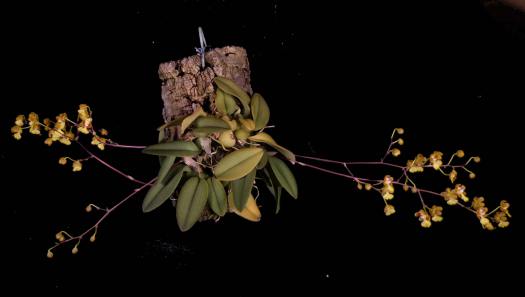 Oncidium harrisonianum
|
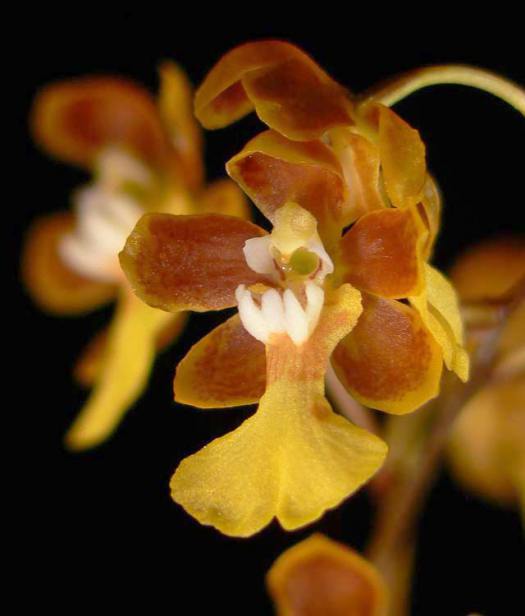 |
 |
|

Vanda barnesiiThis was purchased as V. javierae. There was a group of these that turned out to be the new species V. barnesii. This was the subject of an Orchid Digest article 8 or 9 years ago, shortly after I acquired it. I'd still like to acquire V. javierae too. Both come from the Philippines, from an elevation of about 1200 m. |
|
Coelogyne speciosaWhen I first got this about 10 years ago, it was a very prolific bloomer. Then starting about 4 years ago, it sulked, growing some but not blooming. It seems to have re-awakened. |
|
 Renanthera pulchella2 inch flowers on a 6 inch plant. It grows in bright shade. Not much information about it... IOSPE says it's a hot-growing epiphyte from Myanmar. But for me, it grows just fine outside. |
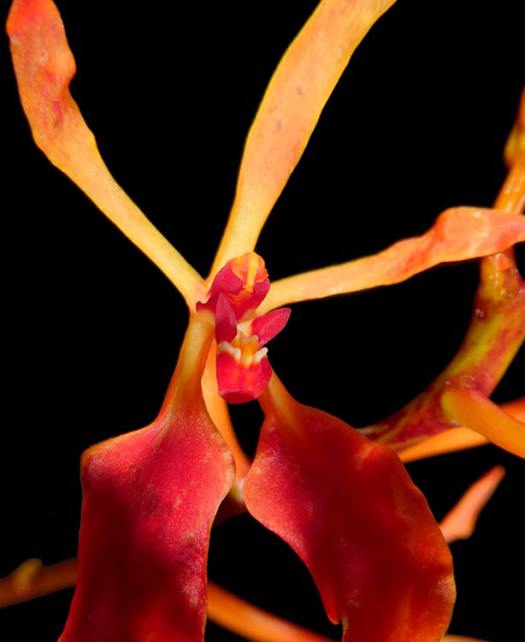 |
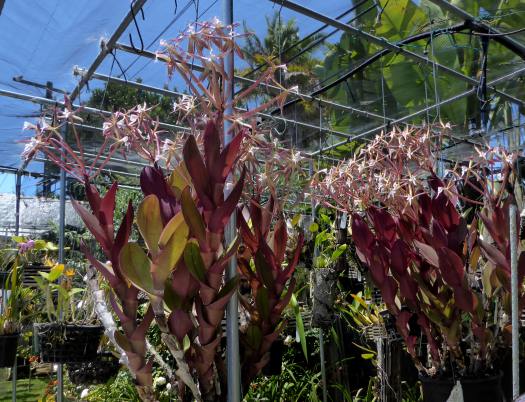 |
|
Epidendrum lacustre 'Wow Fireworks' AM/AOS
|
|
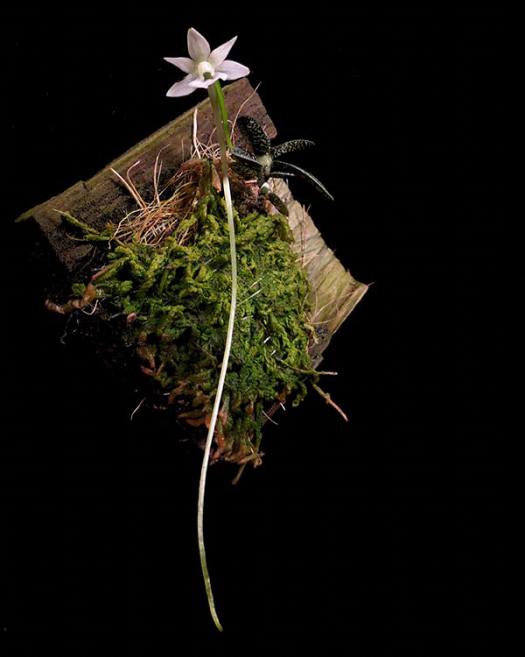 |
|
Angraecum urschianumA 1 cm (3/8 inch) flower with a 10 cm (4 inch) spur. Grows shady and damp. |
|
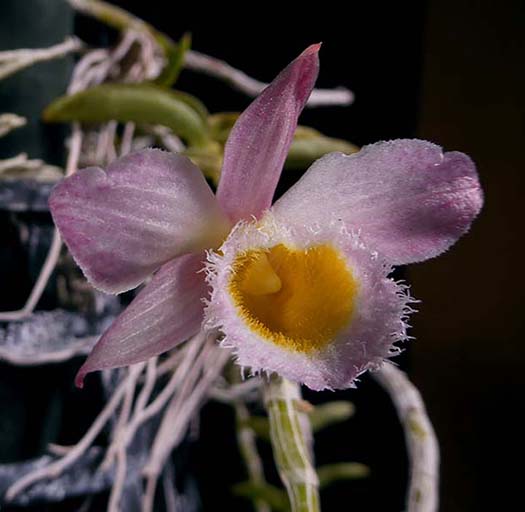 Dendrobium loddigesiiBlooms on old, leafless canes. I dry it out somewhat in winter. The contrast of the pink flower with the egg-yolk yellow throat is dramatic. |
|
Dendrobium toressaeNote thumb for scale. This species forms a mat. Color in the leaves indicats that it is getting close to the maximum light, though it is grown quite shady. |
|
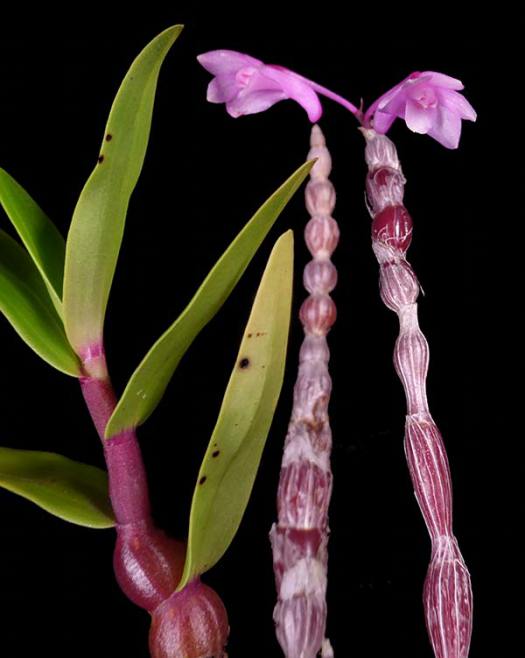
Dendrobium rindjanienseInteresting bumpy canes. it seems to bloom just on the tip of an old, leafless cane. |

Scaphosepalum swertifolium ssp. exiguumFlowers are only about 1/2 inch, but it is now producing quite a few of them. The yellow is the first thing one sees, butg the detail revealed by a photograph is quite beautiful. |
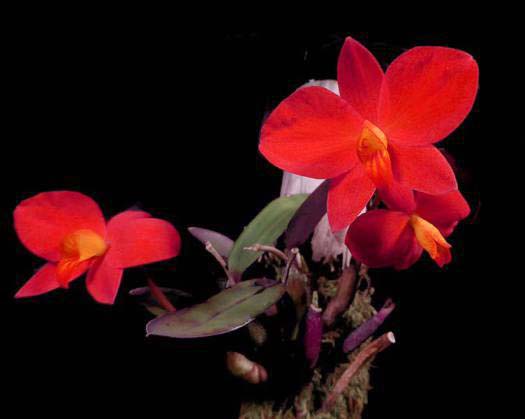
Sophronitis bicolor (Cattleya dichroma)A casualty of the reclassification process... when Sophronitis got lumped into Cattleya, the species name "bicolor" was already taken. A switch from Latin to Greek kept the concept. The briliant yellow sidelobes of the lip make the colors really "pop". This is the best blooming by far for me - along with the three flowers open initially, there are two more buds that will open about the time that the first batch fades. |
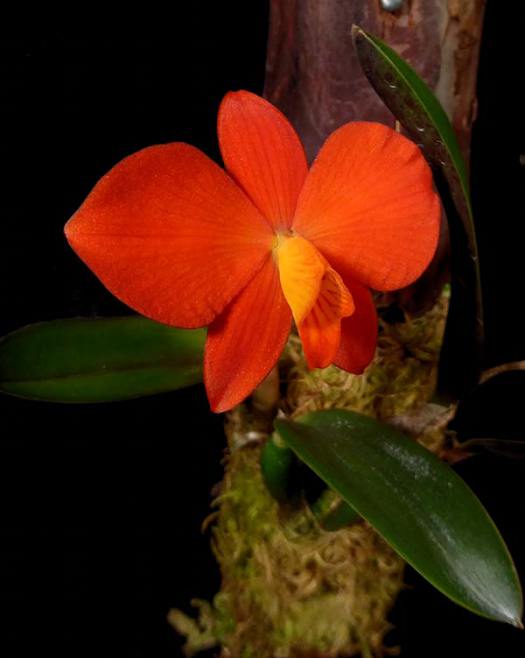 |
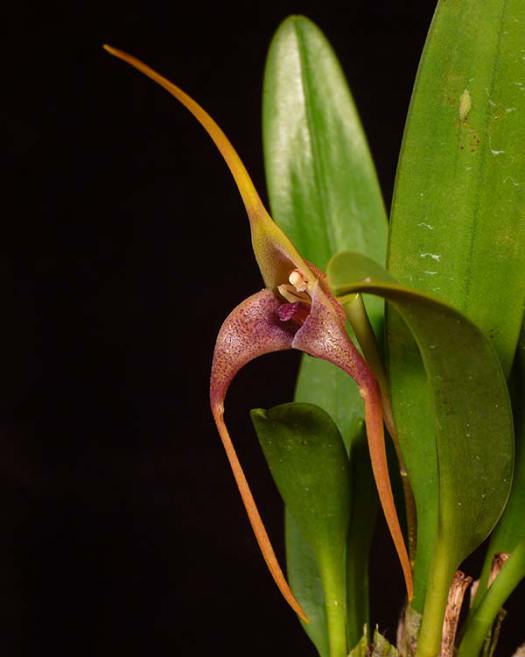 |
 |
Masdevallia colossusAn approximately 4 inch flower, with heavy substance. |
Luisia morseiFlowers cluster at the base of the terete leaves of this Vandaceous species from southern China. 1/2 inch flower, best appreciated in a photograph. |
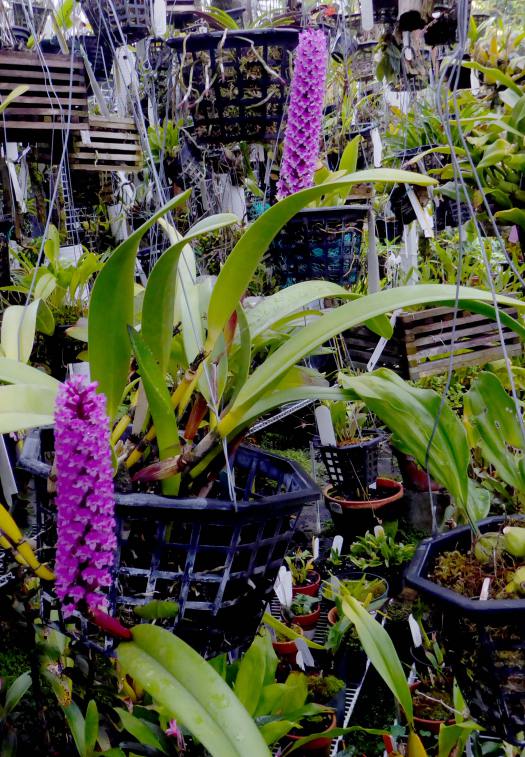
Arpophyllum giganteumThe inflorescences remind me of candles. Hummingbirds are attracted to the flowers - a few years ago one hung around enough for a photo, but usually they are so fast that they disappear faster than the thought to snap a picture. |
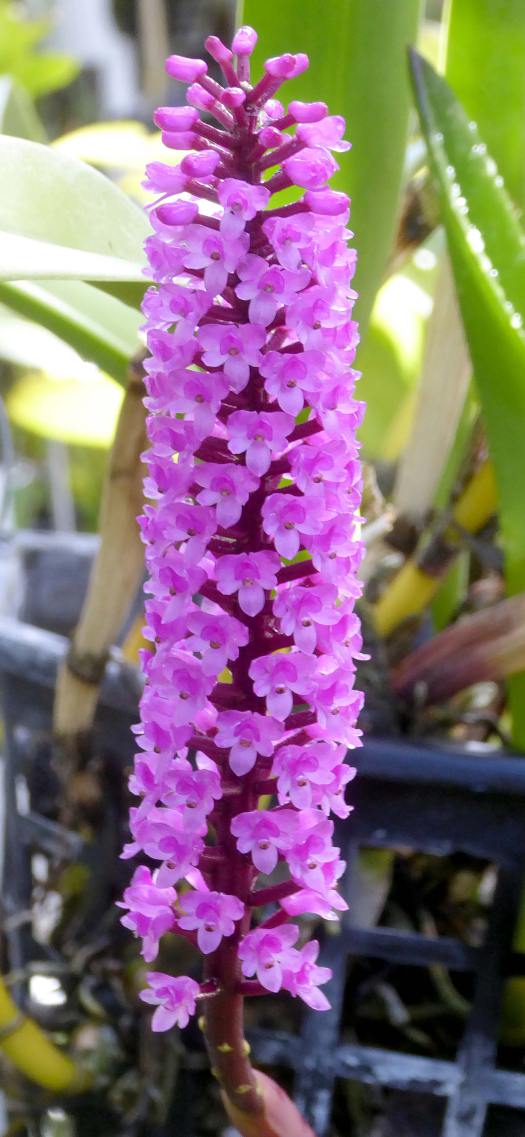 |
 |
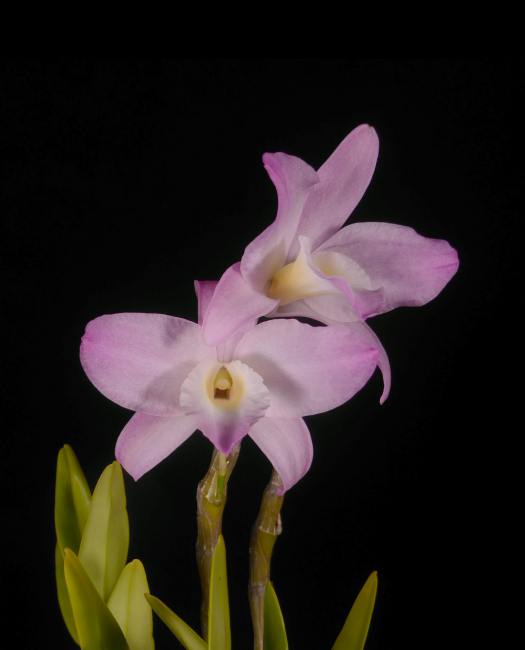 |
Maxillaria fractiflexaA large,and intriguing flower. Three or four spikes, so this one will be in bloom for awhile. |
Dendrobium regiumDelicate flowers float above the plant. |
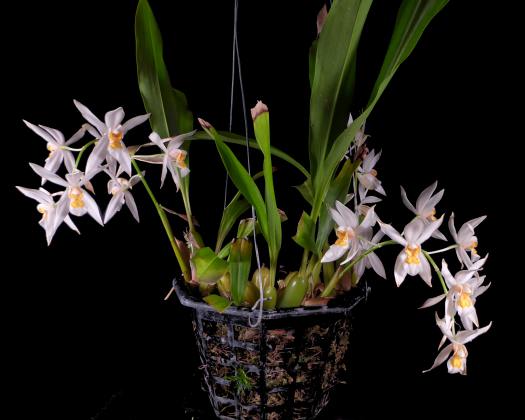
Coelogyne nitidaA compact plant with crystalline white flowers, the golden pattern in the throat is a beautiful contrast. Grows fairly shady and damp. |
 |
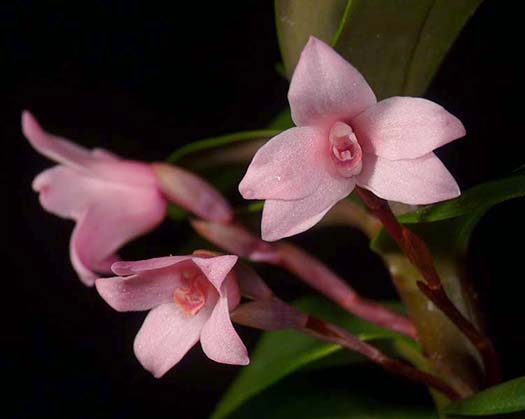
Maxillaria scalariformisThis plant blooms at least twice a year, in the fall as well as the spring. Andy Phillips is able to grow these outside all year, but I have lost several in the winter and can't figure out why. Now, I move the plants into the greenhouse for the coldest months, and have been rewarded with vigorous growth and blooming. It is critical that these never dry out - I grow them in sphagnum. |
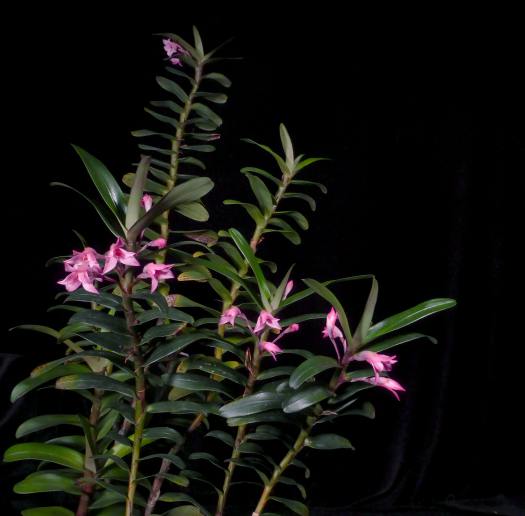 |
 |
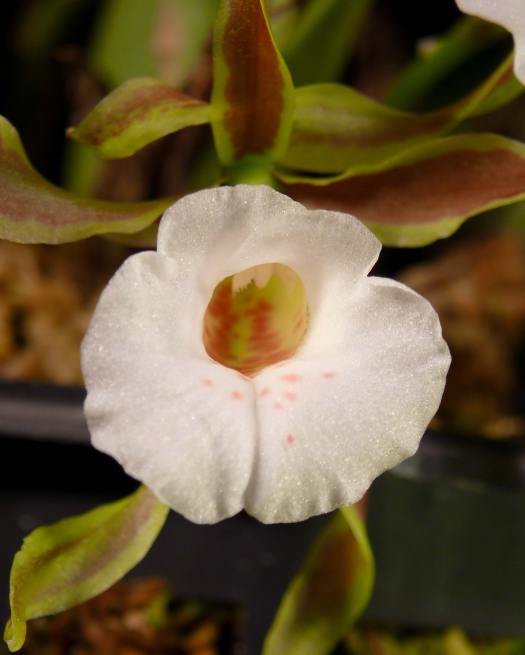 |
Trichopilia tortilisI have found Trichopilias to be tricky - they tend to prefer a fairly narrow temperature range. I grow it very shady, and try to keep it as cool as possible. |
|
In the greenhouse... |
|
Zootrophion alvaroiThe flowers look like little baloons. This is as open as they get. Wonder what could possibly be the pollinator! |
|
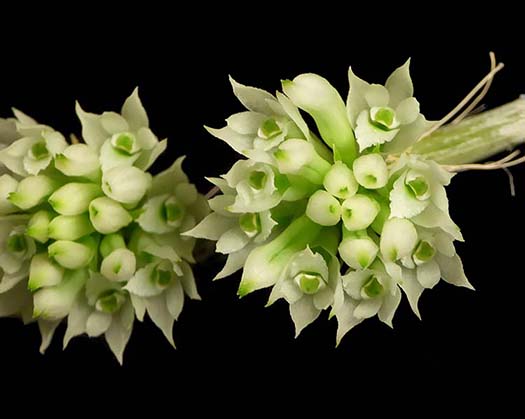 |
|
Dendrobium capituliflorumNot much color, but LOTS of flowers, arranged like pompoms, mainly on old leafless canes. |
|
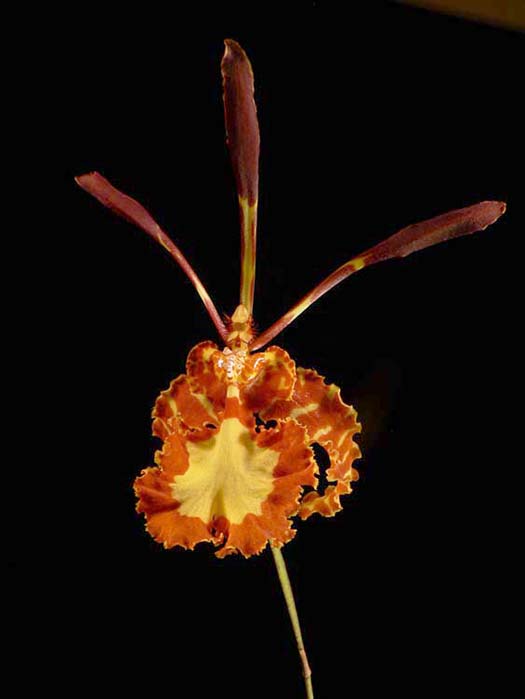 |
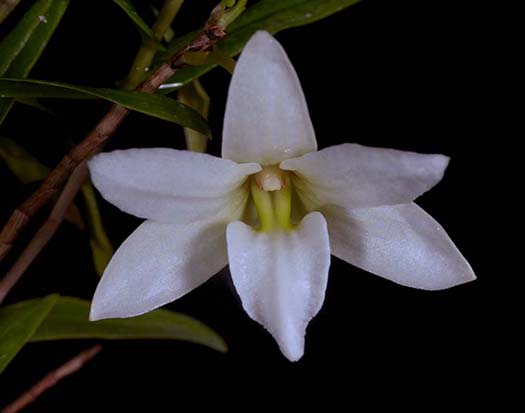
Dendrobium auriculatumThis plant blooms on and off all year. Flowers are sometimes sweetly fragrant. I have two of these, one mounted and one in a pot. The one in the pot grows and blooms much better, it seems to appreciate the extra moisture. It can bloom on both leafed and leafless canes. |
Psychopsis papilioOne of my oldest (about 20 years) orchids. It grew in the upstairs hallway of the condo that I used to have, and now lives in the greenhouse. It doesn't like to be repotted, so I have done that very seldom. The spikes are 3-4 ft long, and bloom sequentially for years. (Don't cut spikes until they are crispy all the way down, even when the tip of a spike is done, it can produce side branches). |
|
